Arusha Tanzania 2006 Day 17 - Ngorongoro Crater and Serengeti National Park
 I'm not a "colonial safari" type by any means. I'm not interested in dressing all in khaki and running after a rhino on a Jeep. We did however want to check out some animals in their (mostly) natural habitat so we hired a local guide and packed the whole family into two trucks for a day of amateur photography. My mom was a the night zoo-keeper at the Washington Park Zoo and worked for the zoo for years and years. She prides herself on her handling of the Asian elephants, although she's never worked with African elephants, so it was a goal to see an elephant or three. Yesterday we headed out from Njiro (outside Arusha where we are staying) to the Ngorongoro Caldera at the Ngorongoro Crater Conservancy/National Park.
I'm not a "colonial safari" type by any means. I'm not interested in dressing all in khaki and running after a rhino on a Jeep. We did however want to check out some animals in their (mostly) natural habitat so we hired a local guide and packed the whole family into two trucks for a day of amateur photography. My mom was a the night zoo-keeper at the Washington Park Zoo and worked for the zoo for years and years. She prides herself on her handling of the Asian elephants, although she's never worked with African elephants, so it was a goal to see an elephant or three. Yesterday we headed out from Njiro (outside Arusha where we are staying) to the Ngorongoro Caldera at the Ngorongoro Crater Conservancy/National Park.
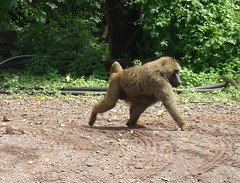 According to Wikipedia, the park is about the size of Crete - about 8300km². Oy. It's interesting as a national park because it also allows human habitation. There were many Maasai in the park herding and we passed some large Maasai bomas. A Boma is a family village, usually fenced in like a smallish compound. The traditional way of life is changing and they don't move around as much as they used to. Inside the park at the second gate to enter the crater itself there are usually a dozen or so kids with an elder hanging back who will literally rush your cars if you stop when you drive in. They are selling necklaces and bracelets and what not, usually asking for TSH5000. You can easily talk them down to TSH2500 or even less per item, but I don't usually haggle when I think that I'm already getting a decent exchange rate and when the money will (presumably) help someone. We picked up some trinkets but we sincerely had to be agressive to keep these gentleman out of our personal space. After having 10 guys push stuff literally in my face, I ended up insisting that they all sit down, (with respect) shut up, and I'd look at their stuff one at a time. We all bought something small, but it was a little "high-pressure" sales environment. :) Fun, nonetheless.
According to Wikipedia, the park is about the size of Crete - about 8300km². Oy. It's interesting as a national park because it also allows human habitation. There were many Maasai in the park herding and we passed some large Maasai bomas. A Boma is a family village, usually fenced in like a smallish compound. The traditional way of life is changing and they don't move around as much as they used to. Inside the park at the second gate to enter the crater itself there are usually a dozen or so kids with an elder hanging back who will literally rush your cars if you stop when you drive in. They are selling necklaces and bracelets and what not, usually asking for TSH5000. You can easily talk them down to TSH2500 or even less per item, but I don't usually haggle when I think that I'm already getting a decent exchange rate and when the money will (presumably) help someone. We picked up some trinkets but we sincerely had to be agressive to keep these gentleman out of our personal space. After having 10 guys push stuff literally in my face, I ended up insisting that they all sit down, (with respect) shut up, and I'd look at their stuff one at a time. We all bought something small, but it was a little "high-pressure" sales environment. :) Fun, nonetheless.
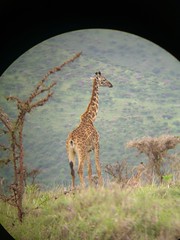 The Caldera is 2000 feet deep and 14 miles across (620m and 22.5km respectively). An estimated 75,000 animals live in the crater itself. The floor is incredibly level and there's a lake inside. It's basically a big, perfect pasture of green in the middle of an extinct volcano. The view from the top is truly amazing. There isn't a wide-angle lens that can really capture what you see. Make sure you bring high-powered binoculars...not the standard 7x35 kind, but a really nice pair. Borrow if you don't want to buy.
The Caldera is 2000 feet deep and 14 miles across (620m and 22.5km respectively). An estimated 75,000 animals live in the crater itself. The floor is incredibly level and there's a lake inside. It's basically a big, perfect pasture of green in the middle of an extinct volcano. The view from the top is truly amazing. There isn't a wide-angle lens that can really capture what you see. Make sure you bring high-powered binoculars...not the standard 7x35 kind, but a really nice pair. Borrow if you don't want to buy.
I'm not a big digital photography guy...well, that's not true. Let's put it this way, I have enough hobbies now, and I know if I got a nice Nikon Digital SLR like Greg Hughes or Omar Shahine then I'd begin the long descent into expensive photography gear, so I've consciously stayed a "snapshot" photographer, knowing full well that photography - the quest for really good photography - would ultimately consume my life. So, my photos suck and it's ok. I even tried sticking the digital camera into the lens of the binoculars and frankly, it didn't turn out too bad if I do say so myself.
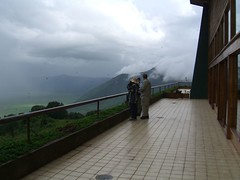 Halfway through we stopped at the very ostentatious Ngorongoro Crater Lodge. If you are looking to spend between US$400 and $US750 a night for a big colonial experience with a private butler, this is the spot. We were not, so we checked out the view and moved on. If you're looking to make two days of it, there are a number of passable inns and hotels in Karatu, a dusty town just 20km outside the park. Suggestion: bring your own treated mosquito nets anyway. It's not worth counting on theirs. The Elbam Annex Inn is a nice and reasonably priced spot. Many of the hotels will overcharge foreigners. Don't be afraid to shop around, but make sure you've left time to do so. We saved money buy packing a lunch ahead of time in Arusha at Shoprite, the Arusha equivalent of Costco. A smidge spendy, but worth it as they have everything you'd want to eat.
Halfway through we stopped at the very ostentatious Ngorongoro Crater Lodge. If you are looking to spend between US$400 and $US750 a night for a big colonial experience with a private butler, this is the spot. We were not, so we checked out the view and moved on. If you're looking to make two days of it, there are a number of passable inns and hotels in Karatu, a dusty town just 20km outside the park. Suggestion: bring your own treated mosquito nets anyway. It's not worth counting on theirs. The Elbam Annex Inn is a nice and reasonably priced spot. Many of the hotels will overcharge foreigners. Don't be afraid to shop around, but make sure you've left time to do so. We saved money buy packing a lunch ahead of time in Arusha at Shoprite, the Arusha equivalent of Costco. A smidge spendy, but worth it as they have everything you'd want to eat.
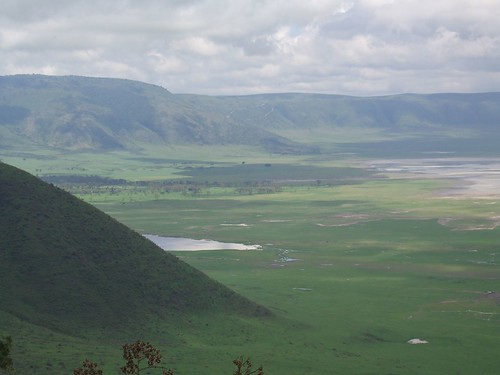
We went with a local Black-owned guide company. They have three cars, and we rented one, a Toyota Land Cruiser, along with a guide. We also brought my sister-in-law's Mitsubishi Pajero. We made sure both SUVs were serviced the day before. Ordinarily you pay the guide a large fee, usually in US dollars, but we negotiated a deal in TSH (Tanzanian Shillings) along with petrol. Basically we filled up both tanks of his giant truck and gave him a flat fee. It worked out OK, but in the future I'd probably check to make sure the guide's car was in a little better shape. We had a flat tire before we even got to the park, plus he didn't have a jack or a lug wrench, so that didn't inspire a great deal of confidence. In the end, though, it was clear the guide knew what he was talking about and it went very smoothly, although we did lose a fuel injector on one of the cars due to dirty petrol, which ultimately reduced the trucks power and made going up hills a problem.
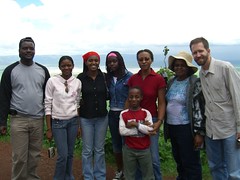 The road from Arusha is tarred, but lousy at best with many potholes. Once you get outside of town about 50km you hang a right and the road suddenly becomes perfectly flat and freshly tarred all the way up to the park entrance. The fees to enter are US$50 for Foreigners and 1500 TSH (about US$1.25) for locals. However, the way it consistently works out (we saw this to be the case in Zimbabwe as well) is that it's 50 bucks for Whites and Indians and local prices for Blacks. Even though we were two trucks with 12 people, 5 Americans (3 white, one black, and the baby), 3 Tanzanians and 4 Zimbabweans, we ended up playing US$ for the whites and everyone else paid local. Apparently this is a known "loophole" and African-Americans on safari can get great prices at local parks and museums if you keep your mouth shut and possibly say a few greetings in kiSwa. Some suspicion was arose on the part of the security guards when the teenage girls started jabbering in English as girls do, and it faded away when we hushed them in Ndebele and told them to switch to kiSwahili. What was going to be a very expensive entrance turned into US$150 and ~30,000TSH including the vehicle fee so that was a pleasant surprise - one my wife, as a Shilling-payer on this expedition, was thrilled with considering her recent Americanization.
The road from Arusha is tarred, but lousy at best with many potholes. Once you get outside of town about 50km you hang a right and the road suddenly becomes perfectly flat and freshly tarred all the way up to the park entrance. The fees to enter are US$50 for Foreigners and 1500 TSH (about US$1.25) for locals. However, the way it consistently works out (we saw this to be the case in Zimbabwe as well) is that it's 50 bucks for Whites and Indians and local prices for Blacks. Even though we were two trucks with 12 people, 5 Americans (3 white, one black, and the baby), 3 Tanzanians and 4 Zimbabweans, we ended up playing US$ for the whites and everyone else paid local. Apparently this is a known "loophole" and African-Americans on safari can get great prices at local parks and museums if you keep your mouth shut and possibly say a few greetings in kiSwa. Some suspicion was arose on the part of the security guards when the teenage girls started jabbering in English as girls do, and it faded away when we hushed them in Ndebele and told them to switch to kiSwahili. What was going to be a very expensive entrance turned into US$150 and ~30,000TSH including the vehicle fee so that was a pleasant surprise - one my wife, as a Shilling-payer on this expedition, was thrilled with considering her recent Americanization.
Inside the park the roads are all dirt. There are barely roads, actually, but are constantly under construction. They're very very rough and the older people had some back and butt trouble with the six hours of severe jostling. Bring a pillow if you have a sensitive tuckus. The roads are being worked on, often by hand using a shovel, and the rains return and undo the work. These roads shall not be moved. I wouldn't recommend driving yourself, better to go with someone who knows what they are doing. The best time to go into the park is first thing in the morning. We headed out of Arusha at 7am and should have left even earlier, like 4 or 5am, but it's a challenge to get a dozen folks and a baby out on time. :) We saw giraffe, cranes, wildebeast, elands, Thompson gazelle, kudu, baboons, colobus monkeys, zebras, water buck, cape buffalo, and five African elephants. Not bad for a day's wanderings.
 On the way out we bought some local art from local artists. Typically the smaller the shop, the better chance you're dealing with the artist, or at least one of his/her relatives. If the place takes credit cards, it's likely a "clearing house" or middle man. We went to a shop run by the uncle of a friend of a friend, so even though we were likely "led" there, we were able to use the local connection to get a bulk rate on five nice original paintings. It's a good idea to have both US dollars and TSH on you, as the question will come up how you're going to pay. Pay in the currency that they prefer and you might get a small break on the total price. Also, do try to speak some Swahili in a respectful way, and hopefully make it all the way through a greeting exchange. Depending on who you're working with, I do distinctly get the impression that they appreciate the effort.
On the way out we bought some local art from local artists. Typically the smaller the shop, the better chance you're dealing with the artist, or at least one of his/her relatives. If the place takes credit cards, it's likely a "clearing house" or middle man. We went to a shop run by the uncle of a friend of a friend, so even though we were likely "led" there, we were able to use the local connection to get a bulk rate on five nice original paintings. It's a good idea to have both US dollars and TSH on you, as the question will come up how you're going to pay. Pay in the currency that they prefer and you might get a small break on the total price. Also, do try to speak some Swahili in a respectful way, and hopefully make it all the way through a greeting exchange. Depending on who you're working with, I do distinctly get the impression that they appreciate the effort.
If you stop your car in any towns that are near the lodge (towns that are not near Arusha) you'll need to be very assertive to make your purchases as crowds tend to form if there is a caravan. We bought some bananas (be sure to ask for "sweet bananas" - the little ones - they are great for cereal or a snack, and much better than the crap Chiquita bananas we have in the US) and also some roasted corn of the side of the road. Highly recommended, both.
About Scott
Scott Hanselman is a former professor, former Chief Architect in finance, now speaker, consultant, father, diabetic, and Microsoft employee. He is a failed stand-up comic, a cornrower, and a book author.
About Newsletter
I recommend taking a Land Rover into the crater and looking for the black Rhinos, bathing Hippos and Elephants - all memories I'll never forget. A buddy's vehicle was charged upon by a black Rhino though <eek!>.
Scott, this is related to another thread where you asked for suggestion on themes for your podcast: I think it would be great if you talk about your travel in Hanselminutes.
Comments are closed.
